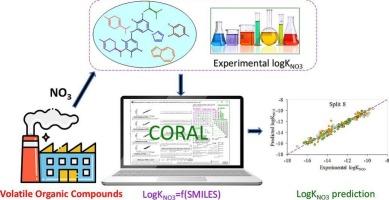Predicting atmospheric degradation rate constant of volatile organic compounds with nitrate radicals using quantitative structure–activity relationship modeling and Monte Carlo optimization
IF 2.4
3区 化学
Q4 CHEMISTRY, PHYSICAL
引用次数: 0
Abstract
In this study, a quantitative structure–activity relationship (QSAR) model was developed using a Monte Carlo-based approach to predict the nitrate radical (NO₃•) reaction rate constant (kNO₃) for 189 volatile organic compounds (VOCs). An optimal hybrid descriptor combining SMILES notation and hydrogen-filled graph (HFG) representation was used for molecular encoding. Forty QSAR models were generated using four different target functions, with the correlation intensity index (TF2) yielding the best performance. The optimal model, selected based on the R2m metric, showed strong statistical performance in split #8 (R2Train = 0.98, R2Calibration = 0.97, R2Validation = 0.93, and R̅2m_calibration = 0.90). Structural features influencing log kNO₃ were identified: enhancing features included the absence of halogens, presence of two aliphatic carbons connected by a double bond, and second-order carbon valence values of six or seven. Decreasing features involved specific oxygen-centered paths and particular extended connectivity values for carbon atoms.

利用定量构效关系模型和蒙特卡罗优化方法预测含硝酸盐自由基的挥发性有机化合物在大气中的降解速率常数
在这项研究中,使用基于蒙特卡罗的方法建立了定量构效关系(QSAR)模型,用于预测189种挥发性有机化合物(VOCs)的硝酸盐自由基(NO₃•)反应速率常数(kNO₃)。将SMILES表示法与氢填充图(HFG)表示法相结合的最优混合描述子用于分子编码。使用4种不同的目标函数生成40个QSAR模型,其中相关强度指数(TF2)表现最佳。基于R2m度量选择的最优模型在分割#8中显示出较强的统计性能(R2Train = 0.98, r2校准= 0.97,r2验证= 0.93,R _ 2m_校准= 0.90)。确定了影响log kNO₃的结构特征:增强特征包括不含卤素,存在两个由双键连接的脂肪碳,以及二阶碳价为6或7。减少的特征包括特定的氧中心路径和碳原子的特定扩展连接值。
本文章由计算机程序翻译,如有差异,请以英文原文为准。
求助全文
约1分钟内获得全文
求助全文
来源期刊

Chemical Physics
化学-物理:原子、分子和化学物理
CiteScore
4.60
自引率
4.30%
发文量
278
审稿时长
39 days
期刊介绍:
Chemical Physics publishes experimental and theoretical papers on all aspects of chemical physics. In this journal, experiments are related to theory, and in turn theoretical papers are related to present or future experiments. Subjects covered include: spectroscopy and molecular structure, interacting systems, relaxation phenomena, biological systems, materials, fundamental problems in molecular reactivity, molecular quantum theory and statistical mechanics. Computational chemistry studies of routine character are not appropriate for this journal.
 求助内容:
求助内容: 应助结果提醒方式:
应助结果提醒方式:


